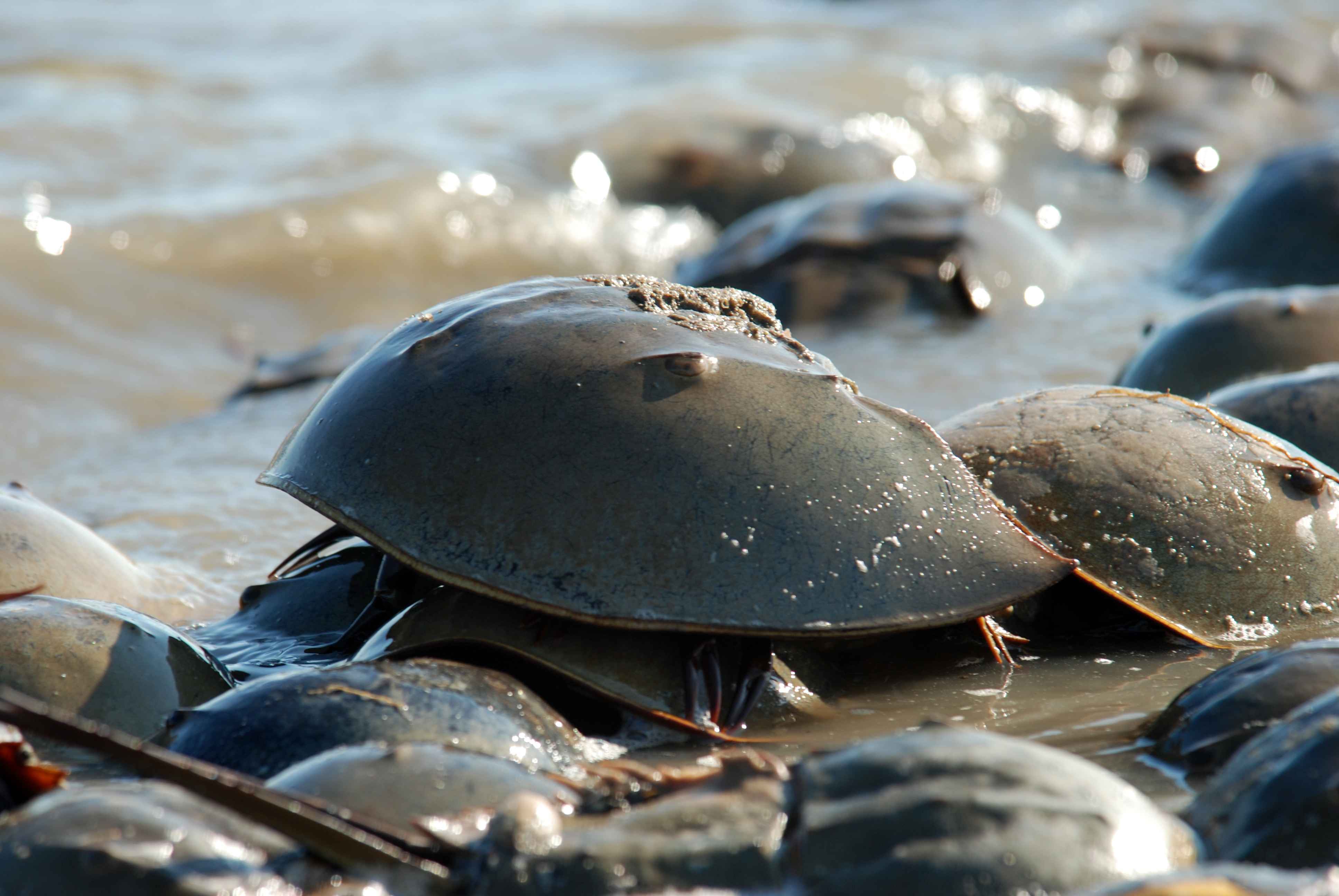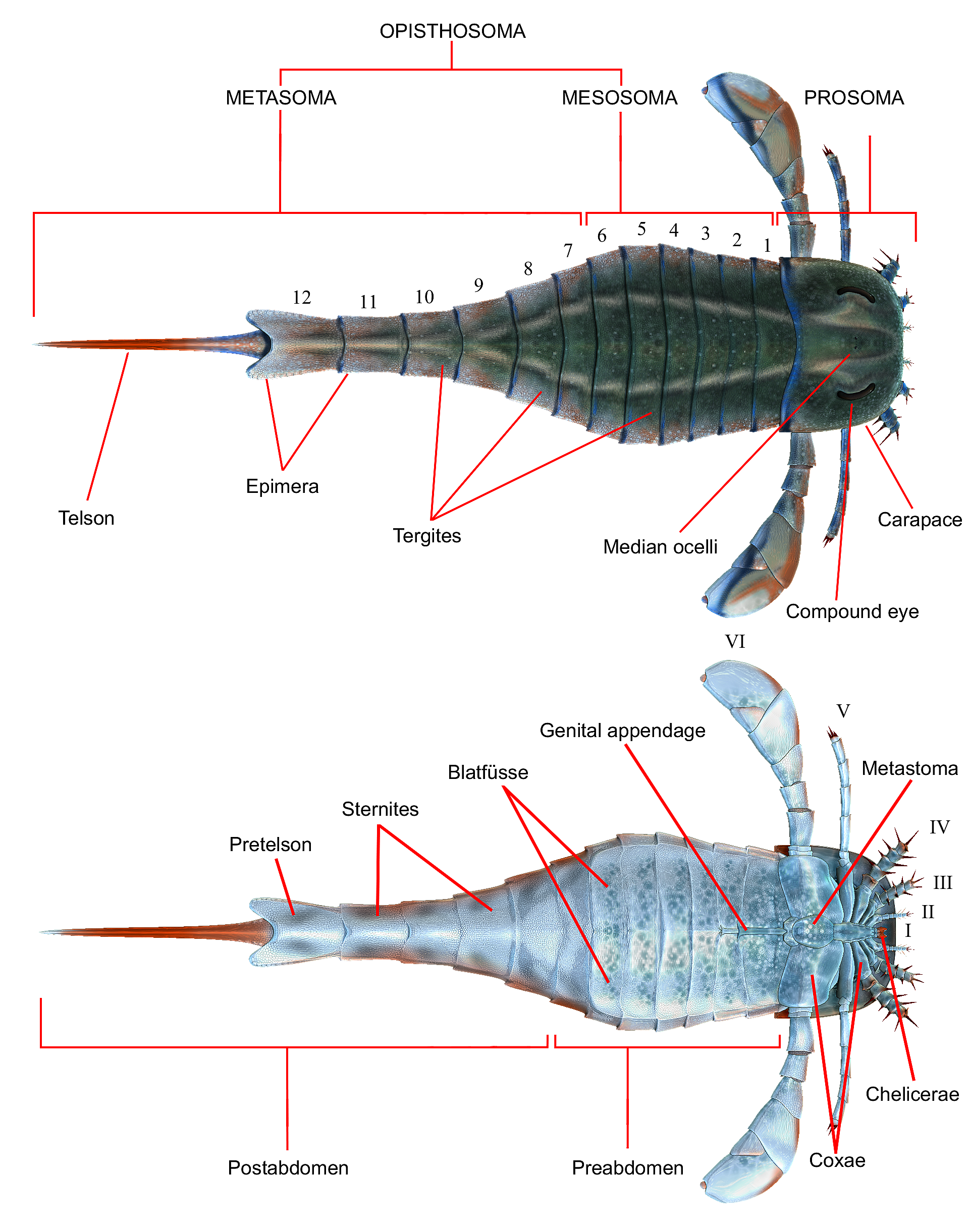|
Xiphosura
Xiphosura (; , in reference to its sword-like telson) is an order of arthropods related to arachnids. They are more commonly known as horseshoe crabs (a name applied more specifically to the only extant family, Horseshoe crab, Limulidae). They first appeared in the Hirnantian (Late Ordovician). Currently, there are only four living species. Xiphosura contains one suborder, Xiphosurida, and several stem-genera. The group has hardly changed in appearance in hundreds of millions of years; the modern horseshoe crabs look almost identical to prehistoric genera and are considered to be living fossils. The most notable difference between ancient and modern forms is that the abdominal segments in present species are fused into a single unit in adults. Xiphosura were historically placed in the class Merostomata, although this term was intended to encompass also the Eurypterida, eurypterids, whence it denoted what is now thought to be an unnatural (paraphyletic) group (although this is a gr ... [...More Info...] [...Related Items...] OR: [Wikipedia] [Google] [Baidu] |
Horseshoe Crab
Horseshoe crabs are arthropods of the family Limulidae and the only surviving xiphosurans. Despite their name, they are not true crabs or even crustaceans; they are chelicerates, more closely related to arachnids like spiders, ticks, and scorpions. The body of a horseshoe crab is divided into three main parts: the cephalothorax, abdomen, and telson. The largest of these, the cephalothorax, houses most of the animal's eyes, limbs, and internal organs. It is also where the animal gets its name, as its shape somewhat resembles that of a horseshoe. Horseshoe crabs have been described as "living fossils", having changed little since they first appeared in the Triassic. Only four species of horseshoe crab are extant today. Most are marine, though the mangrove horseshoe crab is often found in brackish water, and the Atlantic horseshoe crab is resident in brackish estuarine ecosystems such as the Delaware and Chesapeake bays. Additionally, certain extinct species transitioned t ... [...More Info...] [...Related Items...] OR: [Wikipedia] [Google] [Baidu] |
Limulidae
Horseshoe crabs are arthropods of the family Limulidae and the only surviving xiphosurans. Despite their name, they are not true crabs or even crustaceans; they are chelicerates, more closely related to arachnids like spiders, ticks, and scorpions. The body of a horseshoe crab is divided into three main parts: the cephalothorax, abdomen, and telson. The largest of these, the cephalothorax, houses most of the animal's eyes, limbs, and internal organs. It is also where the animal gets its name, as its shape somewhat resembles that of a horseshoe. Horseshoe crabs have been described as "living fossils", having changed little since they first appeared in the Triassic. Only four species of horseshoe crab are extant today. Most are marine, though the mangrove horseshoe crab is often found in brackish water, and the Atlantic horseshoe crab is resident in brackish estuarine ecosystems such as the Delaware and Chesapeake bays. Additionally, certain extinct species transitioned to livi ... [...More Info...] [...Related Items...] OR: [Wikipedia] [Google] [Baidu] |
Atlantic Horseshoe Crab
The Atlantic horseshoe crab (''Limulus polyphemus''), also known as the American horseshoe crab, is a species of horseshoe crab, a kind of marine biology, marine and Brackish water, brackish chelicerate arthropod. It is found in the Gulf of Mexico and along the Atlantic coast of North America. The main area of annual Animal migration, migration is Delaware Bay along the South Jersey Delaware Bayshore. Their eggs were eaten by Indigenous peoples of the Americas, Native Americans, but today Atlantic horseshoe crabs are caught for use as fishing bait, in biomedicine (especially for Limulus amebocyte lysate, ''Limulus'' amebocyte lysate) and science. They play a major role in the local ecosystems, with their eggs providing an important food source for shorebirds, and the juveniles and adults being eaten by sea turtles. The other three Extant taxon, extant (living) species in the family Limulidae are also called horseshoe crabs, but they are restricted to Asia. Despite the name, horse ... [...More Info...] [...Related Items...] OR: [Wikipedia] [Google] [Baidu] |
Willwerathia
''Willwerathia'' is a genus of Devonian arthropod. It is sometimes classified as synziphosurine, a paraphyletic group of horseshoe crab-like fossil chelicerate arthropods, while some studies compare its morphology to an Artiopoda, artiopod. ''Willwerathia'' known only by one species, ''Willwerathia laticeps'', discovered in Deposition (geology), deposits of the Devonian Period (geology), period from the Klerf Formation, in the Rhenish Slate Mountains of Germany. Morphology As a synziphosurine, ''Willwerathia'' is unusually large and so far the largest known synziphosurine, with largest carapace measured about 90mm in width. Prosoma of ''Willwerathia'' covered by a vaulted carapace with pointed genal spines, recurved (M-shaped) ophthalmic ridges and pairs of dorsal nodes. Tergites of the opisthosoma are either incomplete or disarticulated in available fossil materials, making it difficult to reveal the original number of opisthosomal segments. The opisthosoma of ''Willwerathia' ... [...More Info...] [...Related Items...] OR: [Wikipedia] [Google] [Baidu] |
Arachnid
Arachnids are arthropods in the Class (biology), class Arachnida () of the subphylum Chelicerata. Arachnida includes, among others, spiders, scorpions, ticks, mites, pseudoscorpions, opiliones, harvestmen, Solifugae, camel spiders, Amblypygi, whip spiders and Uropygi, vinegaroons. Adult arachnids have eight Arthropod leg, legs attached to the cephalothorax. In some species the frontmost pair of legs has converted to a sensory function, while in others, different appendages can grow large enough to take on the appearance of extra pairs of legs. Almost all Extant taxon, extant arachnids are terrestrial animal, terrestrial, living mainly on land. However, some inhabit freshwater environments and, with the exception of the pelagic zone, marine environments as well. They comprise over 110,000 named species, of which 51,000 are species of spiders. The term is derived from the Ancient Greek, Greek word (''aráchnē'', 'spider'), from the myth of the hubristic human weaver Arachne, w ... [...More Info...] [...Related Items...] OR: [Wikipedia] [Google] [Baidu] |
Eurypterida
Eurypterids, often informally called sea scorpions, are a group of extinct marine arthropods that form the order Eurypterida. The earliest known eurypterids date to the Darriwilian stage of the Ordovician period, 467.3 million years ago. The group is likely to have appeared first either during the Early Ordovician or Late Cambrian period. With approximately 250 species, the Eurypterida is the most diverse Paleozoic chelicerate order. Following their appearance during the Ordovician, eurypterids became major components of marine faunas during the Silurian, from which the majority of eurypterid species have been described. The Silurian genus ''Eurypterus'' accounts for more than 90% of all known eurypterid specimens. Though the group continued to diversify during the subsequent Devonian period, the eurypterids were heavily affected by the Late Devonian extinction event. They declined in numbers and diversity until becoming extinct during the Permian–Triassic extinction e ... [...More Info...] [...Related Items...] OR: [Wikipedia] [Google] [Baidu] |
Arachnid
Arachnids are arthropods in the Class (biology), class Arachnida () of the subphylum Chelicerata. Arachnida includes, among others, spiders, scorpions, ticks, mites, pseudoscorpions, opiliones, harvestmen, Solifugae, camel spiders, Amblypygi, whip spiders and Uropygi, vinegaroons. Adult arachnids have eight Arthropod leg, legs attached to the cephalothorax. In some species the frontmost pair of legs has converted to a sensory function, while in others, different appendages can grow large enough to take on the appearance of extra pairs of legs. Almost all Extant taxon, extant arachnids are terrestrial animal, terrestrial, living mainly on land. However, some inhabit freshwater environments and, with the exception of the pelagic zone, marine environments as well. They comprise over 110,000 named species, of which 51,000 are species of spiders. The term is derived from the Ancient Greek, Greek word (''aráchnē'', 'spider'), from the myth of the hubristic human weaver Arachne, w ... [...More Info...] [...Related Items...] OR: [Wikipedia] [Google] [Baidu] |
Belinuridae
Belinuridae is an extinct family of arthropods belonging to the order Xiphosura Xiphosura (; , in reference to its sword-like telson) is an order of arthropods related to arachnids. They are more commonly known as horseshoe crabs (a name applied more specifically to the only extant family, Horseshoe crab, Limulidae). They fir .... The family consists of several genera. References Xiphosura Prehistoric arthropod families {{Chelicerata-stub ... [...More Info...] [...Related Items...] OR: [Wikipedia] [Google] [Baidu] |
Arthropod
Arthropods ( ) are invertebrates in the phylum Arthropoda. They possess an arthropod exoskeleton, exoskeleton with a cuticle made of chitin, often Mineralization (biology), mineralised with calcium carbonate, a body with differentiated (Metamerism (biology), metameric) Segmentation (biology), segments, and paired jointed appendages. In order to keep growing, they must go through stages of moulting, a process by which they shed their exoskeleton to reveal a new one. They form an extremely diverse group of up to ten million species. Haemolymph is the analogue of blood for most arthropods. An arthropod has an open circulatory system, with a body cavity called a haemocoel through which haemolymph circulates to the interior Organ (anatomy), organs. Like their exteriors, the internal organs of arthropods are generally built of repeated segments. They have ladder-like nervous systems, with paired Anatomical terms of location#Dorsal and ventral, ventral Ventral nerve cord, nerve cord ... [...More Info...] [...Related Items...] OR: [Wikipedia] [Google] [Baidu] |
Austrolimulidae
Austrolimulidae is an extinct family of horseshoe crabs belonging to the infraorder Limulina. Members of the family are known from the Permian to the beginning of the Jurassic, though one species has been reported from the end of the Cretaceous. Austrolimulids are known for amongst the most extreme morphologies among Xiphosurids, including large elongated genal spines. Unlike living Limulids, Austrolimulids were likely adapted for freshwater and brackish environments. They are considered to be the sister group to Limulidae, the group that contains all modern horseshoe crabs. Genera * †'' Austrolimulus'' Riek, 1955 Triassic, Beacon Hill Shale, NSW, Australia * †'' Attenborolimulus'' Bicknell, 2021 Triassic (Olenekian), Petropavlovka Formation, Cis-Urals, Russia * †'' Batracholimulus'' Wilde, 1987 Triassic (Rhaetian), Exter Formation, Germany * †'' Boeotiaspis'' Lamsdell, 2020 Carboniferous, United States ( Jr. synonym) * †'' Casterolimulus'' Holland, Erickson & O'Br ... [...More Info...] [...Related Items...] OR: [Wikipedia] [Google] [Baidu] |
Maldybulakia
''Maldybulakia'' is a genus of freshwater arthropod which lived during Late Silurian to Late Devonian. ''Maldybulakia'' is known from three species, ''M. angusi'' and ''M. malcolmi'' from Australia, ''M. mirabilis'' from Kazakhstan, and ''M. saierensis'' from China. Its classification is uncertain, it was originally described as a myriapod-like animal, and later considered related to the xiphosurans, or an artiopod. Discovery and etymology In 1992, the type species of ''Maldybulakia'' is described from the Pragian to Emsian-aged Sheshen'karinskaya Formation (also known as the Sheshenkarinskoy Suite) in central Kazakhstan, with scientific name ''Lophodesmus mirabilis''. The genus name ''Lophodesmus'' came from the Greek ''lophos'' ("tubercle") and ''desmos'' ("bond"), and the species name ''mirabilis'' means "wonderful" in Latin. However, this genus name is already used for an extant genus of myriapod, and in 1998, the new genus name ''Maldybulakia'', named after Maldybulak F ... [...More Info...] [...Related Items...] OR: [Wikipedia] [Google] [Baidu] |
Kasibelinuridae
''Kasibelinuridae'' is a family of extinct xiphosurans (horseshoe crabs). , two genera are accepted by the Paleobiology Database: *''Kasibelinurus ''Kasibelinurus'' (meaning "sibling of dart tail" for its perceived relation to ''Belinurus'' at the time) is a genus of xiphosuran from the Devonian. It is part of the family Kasibelinuridae. The type species and only species of ''Kasibelinurus' ...'' Pickett, 1993 *'' Pickettia'' Bicknell et al., 2019 References Xiphosura Prehistoric arthropod families Fossil taxa described in 1993 {{paleo-arthropod-stub ... [...More Info...] [...Related Items...] OR: [Wikipedia] [Google] [Baidu] |









